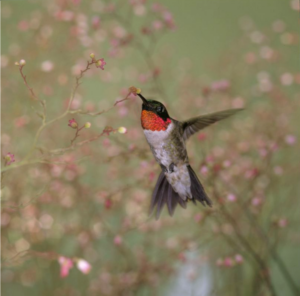In the couple of seconds it takes you to read these first few words, a ruby-throated hummingbird will flap its wings approximately 110 times. Its heart will beat 42 times. If it is drinking nectar, it will have taken 40 distinct sips. It needs to drink fast because, by the end of the day, it will consume between one and seven times its body weight in nectar.
People adore hummingbirds. They’re bugs without all the creepy parts. They buzz and zip around like bees, but they’re colorful and have a “normal” number of limbs. A Facebook group called HummingBird Lovers has 138,000 members.
What we feel for these birds is not the same as what we feel for cardinals or goldfinches. Those birds are beautiful, yes, but familiar.

Hummingbirds, on the other hand, are unlike any other bird. Some things about them are incredible, even weird, especially if we compare them to ourselves. The rate at which they drink nectar, for instance, is equivalent to the average human male drinking over a half-ton of water every day.
When other birds fly, they get lift as they flap their wings down; the upward part of the flapping movement just gets the wings back in place for another downward flap. Hummingbirds, however, flap their wings in a figure-eight motion, giving them lift from both strokes. This way of flying gives hummingbirds unparalleled maneuverability. They are the only birds that can fly forward, backward, and sideways.
This comes with a cost, however — flying like this is exhausting. Pound for pound, their muscles consume 10 times more oxygen than an elite athlete’s do. The human equivalent of the hummingbird’s daily routine would involve burning 150,000 calories, about the same as running 10 marathons. At that rate, it would be easy to starve to death; thus, all that nectar-drinking.
When an organism develops a new life strategy, it inevitably faces challenges that require adaptations. When hummingbirds began hovering, their bodies had to adapt.
First, there’s the challenge of simply consuming enough food to stay alive. To do that, they have evolved to become incredibly skilled at drinking nectar quickly. When a hummingbird visits a food source, it sticks its tongue into the flower and opens a pair of long grooves that run along the side of its tongue; these then fill with nectar. It then closes those grooves and retracts its tongue into its mouth, wringing it and gulping the nectar down before going back for more. It can repeat this process every 14 milliseconds.
For another bird, drinking nectar so quickly would be dangerous, leading to death by overhydration. But hummingbird kidneys are extremely effective at extracting nutrients and minerals from nectar while rapidly excreting liquid, giving them the ability to dilute their waste more than any other bird. They are also able to do the inverse: they essentially turn their kidneys off at night to prevent becoming dehydrated in their sleep.
Sleep itself poses a particular challenge for hummingbirds, as having such a high metabolism theoretically would make it impossible to ever rest without risking starvation. The adaptation in this case is for the hummingbird to enter a deep sleep known as torpor. Its breathing rate drops, its heart rate slows from 1,000 beats per minute to between 50 and 150, and its internal temperature plummets. A study on the high-altitude Andean hummingbird called the black metaltail found its body temperature dropped to 38° F during torpor, the lowest of any nonhibernating bird or mammal.
Hummingbirds’ way of flying has fundamentally changed the way these birds’ bodies work and forced them to adopt what seems like a ludicrously demanding lifestyle. But in the process, they have found a way to access an ecological niche with abundant food and few predators, and they have flourished within it.
For those of us in the Northeast, where we have only our ruby-throats to observe, it’s easy to forget that hummingbirds are among the most successful bird families in the New World. They are found everywhere from Alaska to the southern tip of South America and from coastal deserts to above the tree line in the Andes. And within these varied habitats, they’ve diversified massively. There are 384 species of hummingbirds, according to the Cornell Lab of Ornithology, more than all but two other bird families (tyrant flycatchers and Thraupidae tanagers). While they may be found only in North and South America, they have colonized that area like few other birds have.
And with that diversity comes an incredible range of adaptations and colors. Sword-billed hummingbirds in Ecuador have beaks longer than their bodies. Marvelous spatuletails in Peru have long, wiry tails with two large circles at the ends that they wave above them as they display to females. A study published in Communications Biology in 2022 found that with all the reds, blues, greens, purples, oranges, and browns scattered across the hummingbird family tree, there are more colors present than are found in every other bird on the planet combined.
Even our ruby-throats are special in their own way. Most of the population migrates across the Gulf of Mexico, shooting from the Yucatan peninsula to the southern U.S. and back every year. They gain only a few grams of fat before each crossing, but somehow this is enough to make it to Alabama or Louisiana each spring, where they refuel on nectar before continuing their journeys north.
Each hummingbird that arrives on Cape Cod is a marvel. It is incredible that such a tiny thing managed to migrate here, crossing thousands of miles of sea, forest, and plains to arrive on our little spit of sand. Or that an animal like the ruby-throated hummingbird even exists at all. It’s time to put out your hummingbird feeders.
